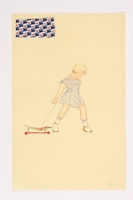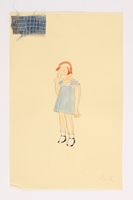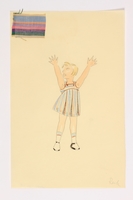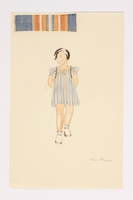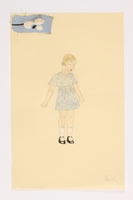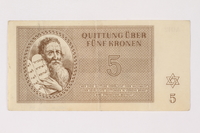Overview
- Credit Line
- United States Holocaust Memorial Museum Collection, Gift of Elizabeth Margosches
Physical Details
- Classification
-
Art
- Category
-
Drawings
- Object Type
-
Fashion drawing (lcsh)
Rights & Restrictions
- Conditions on Access
- No restrictions on access
Administrative Notes
- Legal Status
- Permanent Collection
- Provenance
- The sketch was donated to the United States Holocaust Memorial Museum in 2002 by Elizabeth Margosches.
- Record last modified:
- 2022-07-28 18:30:15
- This page:
- https://collections.ushmm.org/search/catalog/irn533085
Download & Licensing
In-Person Research
- By Appointment
- Request 21 Days in Advance of Visit
- Plan a Research Visit
- Request to See This Object
Contact Us
Also in Elizabeth Margosches family collection
The collection consists of artifacts, design artwork, buttons, coins, pencils, sewing materials, wallets, biographical materials, correspondence, a diary, documents, photographs, books and other printed materials, and immigration, restitution, and subject files relating to the experiences of the Margosches and Reik families in Czechoslovakia, France, England, the United States, and Brazil before, during, and after the Holocaust.
Date: 1888-2010
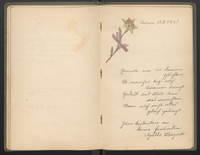
Elizabeth Margosches family papers
Document
The Elizabeth Margosches family papers consist of biographical materials, correspondence, photographs, books and other printed materials, design artwork, immigration files, restitution files, and subject files documenting the lives of the Margosches and Reik families in Czechoslovakia, France, England, the United States, and Brazil before, during, and after World War II. The papers are particularly strong in documenting Karl and Irene Margosches’ efforts to leave Czechoslovakia and eventually immigrate to the United States. The papers also contain a unique diary that Helene Reik composed in Theresienstadt on the backs and in the margins of correspondence and photographs she had brought to the camp or received in the camp. Biographical materials primarily consist of identification papers, forms, certificates, correspondence, and clippings documenting the lives of Irene and Karl Margosches in Czechoslovakia, France, England, and the United States. This series also includes a handful of folders documenting the lives of Karl’s father B. M. (Max) Margosches, his sister Betty Margosches, his first fiancée Herta Langerova, Irene Margosches’ sister Margarete Reik, and Karl and Irene’s daughter Elizabeth. Books consist of five German volumes on music, science, theater, and history owned by Karl Margosches. Correspondence primarily consists of letters and postcards between Irene and Karl Margosches and their family members and friends. The collection also includes correspondence between Helene Reik and her children and Kurt Reik and his family. Topics include plans to emigrate, descriptions of daily life in wartime and postwar Czechoslovakia, England, Brazil, and Canada, and the Margosches family’s postwar life in Princeton. Additional correspondence between Helene Reik and her children can be found among Helene Reik’s Theresienstadt materials. Design artwork by Irene Margosches consists of student assignments from the Kunstgewerbeschule in Vienna in the 1930s and professional work created in Czechoslovakia and England in the 1930s and 1940s. The artwork includes pencil, ink, and water color sketches, studies, and designs for clothing, costumes, and furniture. Small fabric samples are attached to some of the designs. Helene Reik’s Theresienstadt materials consist primarily of family correspondence and family photographs Reik brought with her to Theresienstadt or received while there. She used the margins and versos of many of these records to keep diary entries documenting her time at Theresienstadt in the hospital and nursing home, the illnesses she suffered, the operations she underwent, her memories of her family life before the camp, and her hopes and fears for herself and her children. Immigration files consist of affidavits, applications, correspondence, forms, invoices, and receipts documenting the Margosches’ movements from Czechoslovakia to France, England, and the United States. Photographic materials include a Margosches family album, two travel albums documenting vacations in Germany and Italy, a photo album documenting some of Irene Margosches’ interior designs from 1930s Czechoslovakia, and loose photographs of Karl and Betty Margosches, the Max B. Margosches family in Canada, and Helene, Charlotte, and Margarida Reik. Additional Reik family photographs can be found among the Helene Reik’s Theresienstadt materials. Printed materials consist of chemistry articles, some by B. M. (Max) Margosches and Karl Margosches; clippings on immigration and refugee issues, finding work, and Irene Margosches’ clothing designs; British government publications on wartime provisions, labor, and education; brochures from English hotels; and programs from cultural events in England. Restitution files consist of correspondence, applications, bank records, and forms documenting the Margosches and Reik families’ efforts to receive restitution for property, furnishings, jewelry, securities, insurance policies, and pensions confiscated, lost, interrupted, or damaged during the war. Subject files consist of bibliographies and patent research regarding chemical processes, research into the Holocaust fates of Karl Margosches’ mother and sister, unsuccessful patent applications by Karl Margosches, a group of recipes, a handful of prescriptions and pharmacy envelopes, addresses, and an estimate for the conservation of damaged portraits.
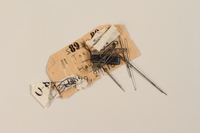
Purse
Object
Purse used by Helene Reik while she was in Thersienstadt ghetto-labor camp in German occupied Czechoslovakia during the Holocaust.

Red leather pouch used by a Czech Jewish inmate in Theresienstadt
Object
Pouch used by Helene Reik while she was interned in Theresienstadt ghetto-labor camp in German occupied Czechoslovakia, beginning in Janaury 1942. Helene died there in 1943 from an infection following several surgeries performed in the camp hospital.

Monogrammed paper pouch with a painted floral design used in the Theresienstadt ghetto
Object
Pouch was used by Helene Reik to hold correspondence sent to her while she was in the ghetto in Terezín (Theresienstadt), Czechoslovakia (now Czech Republic) during the Holocaust.
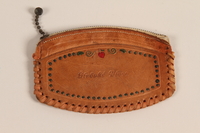
Wallet
Object
The wallet was used by Helene Reik while she was in the ghetto in Terezín (Theresienstadt), Czechoslovakia (now Czech Republic) during the Holocaust.

Wallet
Object
The wallet was used by Helene Reik while she was in the ghetto in Terezín (Theresienstadt), Czechoslovakia (now Czech Republic) during the Holocaust.
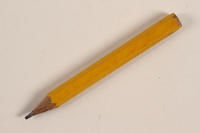
Pencil
Object
The pencil was used by Helene Reik while she was in the ghetto in Terezín (Theresienstadt), Czechoslovakia (now Czech Republic) during the Holocaust.
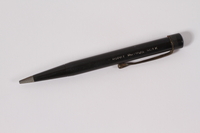
Pencil
Object
The pencil was used by Helene Reik while she was in the ghetto in Terezín (Theresienstadt), Czechoslovakia (now Czech Republic) during the Holocaust.

Eraser
Object
The eraser was used by Helene Reik while she was in the ghetto in Terezín (Theresienstadt), Czechoslovakia (now Czech Republic) during the Holocaust.

Coin
Object

Coin
Object
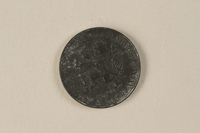
Coin
Object
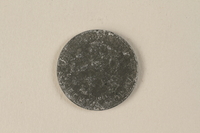
Coin
Object
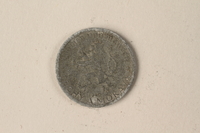
Coin
Object
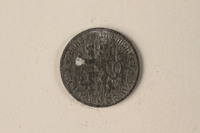
Coin
Object

Coin
Object
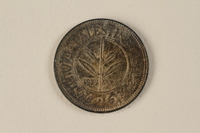
Coin
Object
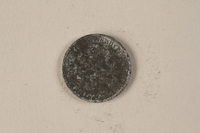
Coin
Object
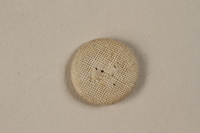
Button
Object
The button belonged to Helene Reik while she was in the ghetto in Terezín (Theresienstadt), Czechoslovakia (now Czech Republic) during the Holocaust.
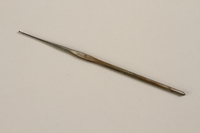
Crochet hook used in the Theresienstadt ghetto
Object
Crochet hook used by Helene Reik while she was imprisoned in the ghetto in Terezin (Theresienstadt), Czechoslovakia (now Czech Republic) during the Holocaust. Helene Reik died in 1943 from an infection as a result of several surgeries performed on her in the Theresienstadt ghetto.
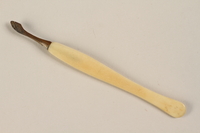
Cuticle pusher
Object
The manicure tool was used by Helene Reik while she was in the ghetto in Terezín (Theresienstadt), Czechoslovakia (now Czech Republic) during the Holocaust.

Manicure scissors
Object
The manicure scissors were used by Helene Reik while she was in the ghetto in Terezín (Theresienstadt), Czechoslovakia (now Czech Republic) during the Holocaust.

Unfinished lace circle with scalloped edges owned by a prisoner in Theresienstadt ghetto/labor camp
Object
Unfinished lace circle and thread ball that belonged to Helene Reik while she was imprisoned in the Theresienstadt ghetto/labor camp in German occupied Czechoslovakia. Helene died in 1943 from an infection as a result of several surgeries performed on her in the camp.

White ribbon with U-481 written repeatedly owned by a Jewish woman in Theresienstadt
Object
bbon belonged to Helene Reik while she was in the ghetto in Terezín (Theresienstadt), Czechoslovakia (now Czech Republic) during the Holocaust.

Two round glass lenses, two green plastic legs and; green plastic pieces of frame from the Theresienstadt ghetto
Object
The eyeglasses were used by Helene Reik while she was in the ghetto in Terezín (Theresienstadt), Czechoslovakia (now Czech Republic) during the Holocaust.

Lock of hair
Object
Golden-brown lock of hair belonging to Helene Reik and cut by her shortly before she died.
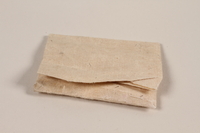
Package of white powder
Object
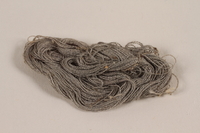
Gray darning thread
Object
The thread belonged to Helene Reik while she was in the ghetto in Terezín (Theresienstadt), Czechoslovakia (now Czech Republic) during the Holocaust.
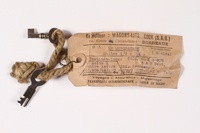
Trunk keys
Object
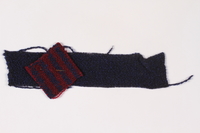
Fabric samples
Object

Czech postage stamps, 120K
Object
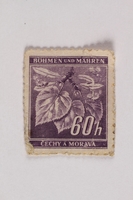
Czech postage stamps, 60H
Object
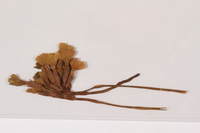
Dried and Pressed Flower
Object
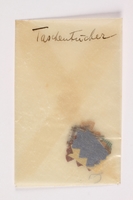
Fabric samples
Object
Name tag
Object
Pencil
Object
The pencil was used by Helene Reik while she was in the ghetto in Terezín (Theresienstadt), Czechoslovakia (now Czech Republic) during the Holocaust.
Trunk
Object
The trunk belonged to Helene Reik while she was in the ghetto in Terezín (Theresienstadt), Czechoslovakia (now Czech Republic) during the Holocaust.


